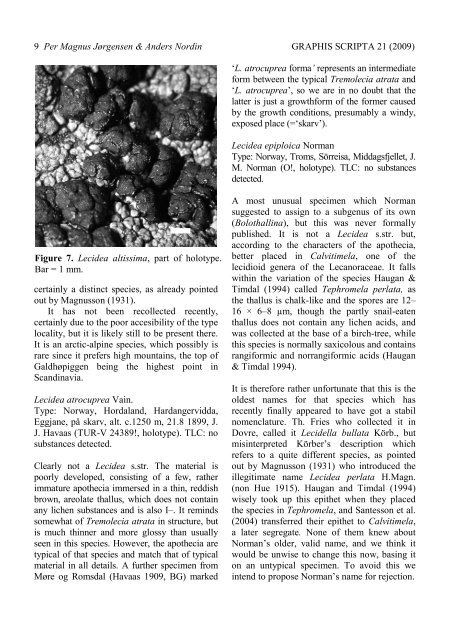(2009): Lichens in Scandinavia known mainly from Norwegian type ...
(2009): Lichens in Scandinavia known mainly from Norwegian type ...
(2009): Lichens in Scandinavia known mainly from Norwegian type ...
Create successful ePaper yourself
Turn your PDF publications into a flip-book with our unique Google optimized e-Paper software.
9 Per Magnus Jørgensen & Anders Nord<strong>in</strong> GRAPHIS SCRIPTA 21 (<strong>2009</strong>)<br />
Figure 7. Lecidea altissima, part of holo<strong>type</strong>.<br />
Bar = 1 mm.<br />
certa<strong>in</strong>ly a dist<strong>in</strong>ct species, as already po<strong>in</strong>ted<br />
out by Magnusson (1931).<br />
It has not been recollected recently,<br />
certa<strong>in</strong>ly due to the poor accesibility of the <strong>type</strong><br />
locality, but it is likely still to be present there.<br />
It is an arctic-alp<strong>in</strong>e species, which possibly is<br />
rare s<strong>in</strong>ce it prefers high mounta<strong>in</strong>s, the top of<br />
Galdhøpiggen be<strong>in</strong>g the highest po<strong>in</strong>t <strong>in</strong><br />
Scand<strong>in</strong>avia.<br />
Lecidea atrocuprea Va<strong>in</strong>.<br />
Type: Norway, Hordaland, Hardangervidda,<br />
Eggjane, på skarv, alt. c.1250 m, 21.8 1899, J.<br />
J. Havaas (TUR-V 24389!, holo<strong>type</strong>). TLC: no<br />
substances detected.<br />
Clearly not a Lecidea s.str. The material is<br />
poorly developed, consist<strong>in</strong>g of a few, rather<br />
immature apothecia immersed <strong>in</strong> a th<strong>in</strong>, reddish<br />
brown, areolate thallus, which does not conta<strong>in</strong><br />
any lichen substances and is also I–. It rem<strong>in</strong>ds<br />
somewhat of Tremolecia atrata <strong>in</strong> structure, but<br />
is much th<strong>in</strong>ner and more glossy than usually<br />
seen <strong>in</strong> this species. However, the apothecia are<br />
typical of that species and match that of typical<br />
material <strong>in</strong> all details. A further specimen <strong>from</strong><br />
Møre og Romsdal (Havaas 1909, BG) marked<br />
‘L. atrocuprea forma’ represents an <strong>in</strong>termediate<br />
form between the typical Tremolecia atrata and<br />
‘L. atrocuprea’, so we are <strong>in</strong> no doubt that the<br />
latter is just a growthform of the former caused<br />
by the growth conditions, presumably a w<strong>in</strong>dy,<br />
exposed place (=‘skarv’).<br />
Lecidea epiploica Norman<br />
Type: Norway, Troms, Sörreisa, Middagsfjellet, J.<br />
M. Norman (O!, holo<strong>type</strong>). TLC: no substances<br />
detected.<br />
A most unusual specimen which Norman<br />
suggested to assign to a subgenus of its own<br />
(Bolothall<strong>in</strong>a), but this was never formally<br />
published. It is not a Lecidea s.str. but,<br />
accord<strong>in</strong>g to the characters of the apothecia,<br />
better placed <strong>in</strong> Calvitimela, one of the<br />
lecidioid genera of the Lecanoraceae. It falls<br />
with<strong>in</strong> the variation of the species Haugan &<br />
Timdal (1994) called Tephromela perlata, as<br />
the thallus is chalk-like and the spores are 12–<br />
16 × 6–8 µm, though the partly snail-eaten<br />
thallus does not conta<strong>in</strong> any lichen acids, and<br />
was collected at the base of a birch-tree, while<br />
this species is normally saxicolous and conta<strong>in</strong>s<br />
rangiformic and norrangiformic acids (Haugan<br />
& Timdal 1994).<br />
It is therefore rather unfortunate that this is the<br />
oldest names for that species which has<br />
recently f<strong>in</strong>ally appeared to have got a stabil<br />
nomenclature. Th. Fries who collected it <strong>in</strong><br />
Dovre, called it Lecidella bullata Körb., but<br />
mis<strong>in</strong>terpreted Körber’s description which<br />
refers to a quite different species, as po<strong>in</strong>ted<br />
out by Magnusson (1931) who <strong>in</strong>troduced the<br />
illegitimate name Lecidea perlata H.Magn.<br />
(non Hue 1915). Haugan and Timdal (1994)<br />
wisely took up this epithet when they placed<br />
the species <strong>in</strong> Tephromela, and Santesson et al.<br />
(2004) transferred their epithet to Calvitimela,<br />
a later segregate. None of them knew about<br />
Norman’s older, valid name, and we th<strong>in</strong>k it<br />
would be unwise to change this now, bas<strong>in</strong>g it<br />
on an untypical specimen. To avoid this we<br />
<strong>in</strong>tend to propose Norman’s name for rejection.

















